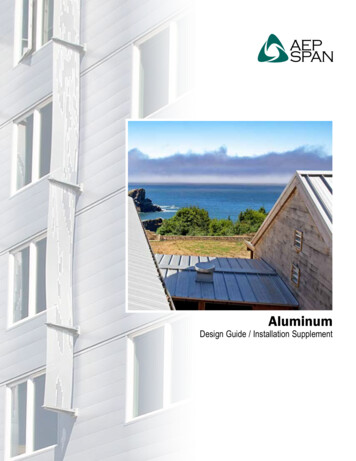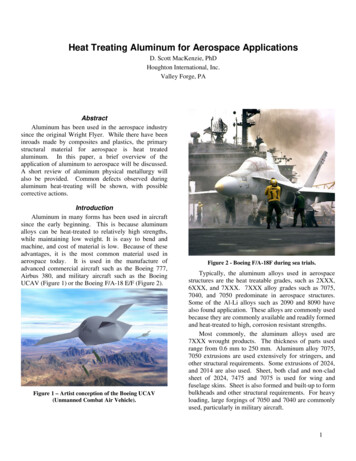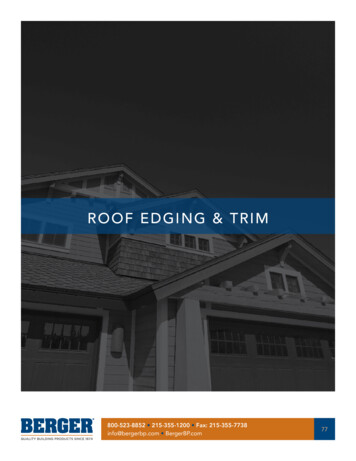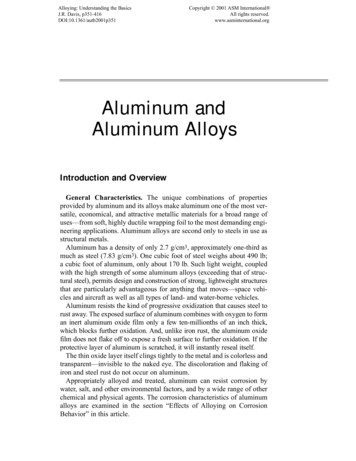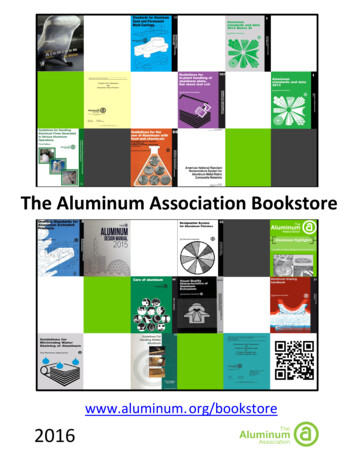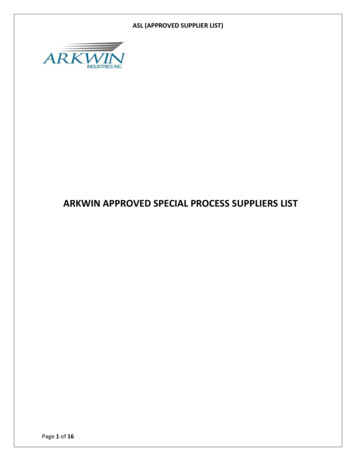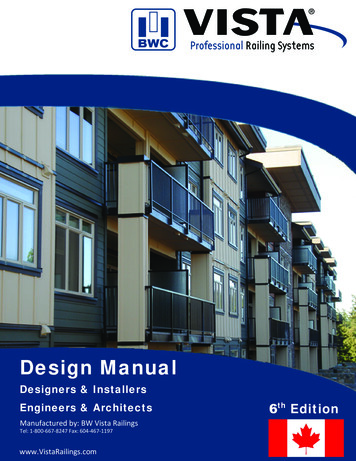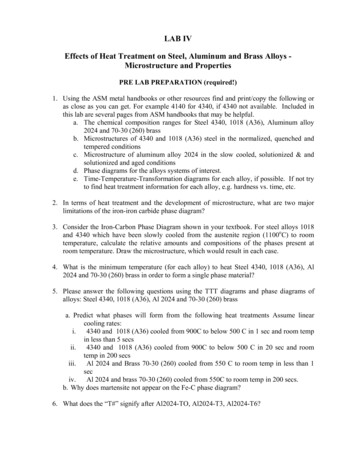
Transcription
Aluminum Alloys and Heat TreatmentSemih Genculu, P.E.Aluminum is best known for its lightweight, corrosion resistance, and attractive appearance although other propertiesmay be equally important-such as its good electrical and thermal conductivity, its high reflectivity, and non-sparkingcharacteristics. Since pure aluminum is soft with only moderate strength, most applications for aluminum will involvealuminum alloys, as the addition of alloying constituents greatly increases both strength and hardness.With the growth of aluminum within a wide range of industries, and its acceptance as an excellent alternative to steelfor many applications, there are increasing requirements for those involved with developing aluminum projects tobecome more familiar with this group of materials. To fully understand aluminum, it is advisable to start by becomingacquainted with the aluminum identification/designation system, the many aluminum alloys available and theircharacteristics.In North America, The Aluminum Association Inc. is responsible for the allocation and registration of aluminum alloys.Currently there are over 400 wrought aluminum and aluminum alloys. Aluminum alloys can be categorized into anumber of groups based on the particular material’s characteristics such as its ability to respond to thermal andmechanical treatment and the primary alloying element added to the aluminum alloy.Wrought Alloy Designation System:In the 4-digit wrought aluminum alloy identification system, the first digit (Xxxx) indicates the principal alloying element,which has been added to the aluminum alloy and is often used to describe the aluminum alloy series, i.e., 1000 series,2000 series, 3000 series, up to 8000 series (see Table 1).The second single digit (xXxx), if different from 0, indicates a modification of the specific alloy, and the third and fourthdigits (xxXX) are arbitrary numbers given to identify a specific alloy in the series. Example: In alloy 5183, the number 5indicates that it is of the magnesium alloy series, the 1 indicates that it is the 1st modification to the original alloy 5083,and the 83 identifies it in the 5xxx series.The only exception to this alloy numbering system is with the 1xxx series aluminum alloys (pure aluminums) in whichcase, the last 2 digits provide the minimum aluminum percentage above 99%, i.e., Alloy 13(50) (99.50% minimumaluminum).WROUGHT ALUMINUM ALLOY DESIGNATION SYSTEMAlloy SeriesPrincipal Alloying Element1xxxNone, 99.000% Minimum Pure esium6xxxMagnesium and Silicon7xxxZinc and Magnesium8xxxOther Elements (Iron or Lithium)Table 1Heat-Treatable Alloys:Alloys in this group derive their strength from alloying elements such as copper, magnesium, zinc, and silicon. Sincethese elements show increasing solid solubility in aluminum with increasing temperature, it is possible to subject thesealloys to thermal treatments, which will impart pronounced strengthening. Aluminum alloys have been the material of
choice for aircraft construction since the 1930s. The aerospace industry relies heavily on 2xxx and 7xxx alloys, while6xxx aluminum alloys are of particular interest since they have numerous benefits including medium strength,formability, weldability, corrosion resistance, and low cost. 6xxx can be used in a variety of applications includingaircraft fuselage skins and automobile body panels and bumpers, instead of more expensive 2xxx and 7xxx alloys,after appropriate heat treatments. Aluminum is also widely used in other transportation industries such as passengerships, and trains.To improve properties and enhance strength and ductility, aluminum alloys are thermally processed by a series ofheating and cooling cycles called heat treatment. This thermal processing involves three basic operations: solutionheat treatment, rapid cooling (quench) and natural or artificial aging. The first step, solution heat treatment, is anelevated temperature process designed to dissolve the soluble eutectic constituents and put them into solid solution.The temperatures used for solution heat treating vary with different alloys and range from 825 to 980 F (441 to 527 C).As a rule, they must be controlled within a very narrow range ( 10 F) to obtain specified properties. If the temperatureis too low, maximum strength will not be obtained. When excessive temperatures are used, there is danger of meltingthe low melting constituents (eutectic melting) of some alloys with consequent lowering of the physical properties ofthe alloy. Even if melting does not occur, the use of higher than recommended temperatures promotes discolorationand increases quenching strains. During solution treatment, some alloying elements are dissolved to produce a soluterich solid solution. The objective of this process is to maximize the concentration of hardening elements includingcopper, zinc, magnesium, and (or) silicon in the solid solution. The concentration and rate of dissolution of theseelements increases with temperature. For example, in the case of 2024, the major alloy element is copper, and bytaking the part to 920 F (493 C), the copper present within the 2024 will dissolve or disperse uniformly throughout thesolid aluminum matrix.Figure illustrating the heat treating process for an Aluminum-Copper alloyThe time at temperature, referred to as soaking time, is measured from the time the coldest metal reaches theminimum limit of the desired temperature range. The soaking time varies, depending upon the alloy and thickness,from 10 minutes for thin sheets to approximately 12 hours (for heavy forgings). For the heavy sections, the nominalsoaking time is approximately 1 hour for each inch of cross-sectional thickness. The minimum soaking time necessaryto develop the required physical properties should be chosen. The effect of an abbreviated soaking time is obvious;the constituents will not be taken into solution effectively. An excessive soaking period on the other hand, aggravateshigh temperature oxidation. With clad material, prolonged heating results in excessive diffusion of copper and othersoluble constituents into the protective cladding, reduce the corrosion resistance of the alloy and may defeat thepurpose of cladding.After the soluble constituents are in solid solution, the material is quenched to prevent or retard immediate reprecipitation. This is accomplished by rapid quenching, usually in water, which "freezes" the metallurgical structure inplace and for a short time renders the alloy very workable. It is at this stage that some fabricators retain this moreworkable structure by storing the alloys at below freezing temperatures until they are ready to form them. At room orelevated temperatures most alloys are not stable after quenching however, and precipitation of the constituents fromthe super-saturated solution commences. After a period of several days at room temperature, termed natural aging,
the alloy is considerably stronger. Many alloys approach a stable condition at room temperature, but some alloys,particularly those containing magnesium and silicon or magnesium and zinc, continue to age harden for long periodsof time at room temperature. By heating for a controlled time at slightly elevated temperatures, even furtherstrengthening is possible and properties are stabilized. This process is called artificial aging or precipitation hardening.The precipitants formed and grown by artificial aging are more controlled and substantial in nature, resulting in highermechanical properties as compared to naturally aged conditions.The temperatures used for precipitation hardening depend upon the alloy and the properties desired, ranging from 225to 375 F (107 to 191 C). These should also be controlled within a very narrow range ( 5 F) to obtain best results. Thetime at temperature is dependent upon the temperature used, the properties desired, and the alloy. It ranges from 4 to24 hours. Increasing the aging temperature decreases the soaking period necessary for proper aging. However, acloser control of both time and temperature is necessary when using the higher temperatures. After receiving thethermal precipitation treatment, the material should be air cooled to room temperature. Furnace cooling has atendency to produce over-aging. Over-aging is softening resulting from prolonged aging. Maximum hardening isassociated with an optimum small particle size and a corresponding large number of particles; while over-aging isassociated with few relatively large particles.Natural aging curves for three solution heat treated aluminum alloysPrecipitation heat treatment or artificial aging curves for solution heat treated and quenchedaluminum alloy 6061 (Al-Mg-Si) show the changes that occur with increasing time at each of a series of temperatures.
By the proper combination of solution heat treatment, quenching, cold working and aging the highest strengths areobtained. In the case of natural aging of 2024 (i.e. aging at room temperature), the dissolved copper slowly comesback out of solution over an extended time (96 hours minimum), forming CuAl precipitants. Precipitated particles inheat treatable aluminum alloys strengthen the alloy by pinning or locking up numerous microstructural features in thealuminum.Other heat treatable alloys like 6061 and 7075 undergo very similar precipitation reactions, with the actual precipitatedparticles differing depending on whether zinc, magnesium, manganese, silicon or copper additions are present. Theway that metallurgists control the formation of these precipitants will determine the alloy's mechanical and corrosionproperties.Non-heat treatable Alloys:The non-heat treatable alloys acquire their optimum mechanical properties through strain hardening. Strain hardeningis the method of increasing strength through the application of cold working. Cold working occurs during rolling orforging methods and is the action of “working” the metal to make it stronger. For example, when rolling aluminumdown to thinner gauges, it gets stronger. This is because cold working builds up dislocations and vacancies in thestructure, which then inhibits the movement of atoms relative to each other. This increases the strength of themetal. Alloying elements like magnesium intensify this effect, resulting in even higher strength.Clad Alloys:The addition of appreciable amounts of copper to aluminum to form precipitation-hardening alloys materially reducesthe corrosion resistance of the aluminum. This is particularly true for alloys 2014, 2024, 7075, and modifications ofthese alloys. If a surface layer of pure aluminum or copper-free aluminum is applied to these alloys by a processknown as cladding, a composite product is formed which provides the high strength of the core alloy protected by acorrosion resistant skin. Alclad is therefore a duplex metal product that has a metallurgically bonded "coating" resultingin increased resistance to corrosion. It is a sandwich of high-strength aluminum alloy between two sheets ofcommercially pure metal for a combination of strength and corrosion resistance produced by rolling. The use of Alcladresults in greatly increased life for a structural part. It is an Alcoa trademark name for high-strength sheet aluminumclad with a layer (approximately 5-10% of the total thickness) of high-purity aluminum, popularly used in airplanemanufacture.Micrograph Showing an Aluminum Alloy with a Clad layerThe Aluminum Temper Designation System:The temper designation system is used for all forms of wrought and cast aluminum and aluminum alloys. It is based onthe sequence of basic treatments used to produce the various tempers. The temper designation follows the alloydesignation, the two being separated by a dash.The 1xxx, 3xxx, and 5xxx series wrought aluminum alloys are non-heat treatable and are strain hardenable only (i.e.
by cold working). The 2xxx, 6xxx, and 7xxx series wrought aluminum alloys are heat treatable and the 4xxx seriesconsist of both heat treatable and non-heat treatable alloys.The temper designation follows the alloy designation, 6061-T6 for example. A "temper" refers to a condition producedin the metal by mechanical working or heat treatment. Further to the basic temper designation, there are twosubdivision categories, one addressing the “H” Temper – Strain Hardening, and the other addressing the “T” Temper –Thermally Treated designation.THE BASIC TEMPER DESIGNATIONSDescriptionLetterFAs fabricated – Applies to products of a forming process in which nospecial control over thermal or strain hardening conditions is employedOAnnealed – Applies to product which has been heated to produce thelowest strength condition to improve ductility and dimensional stabilityHStrain Hardened – Applies to products that are strengthened through coldworking. The strain hardening may be followed by supplementary thermaltreatment, which produces some reduction in strength. The “H” is alwaysfollowed by two or more digits (see subdivisions of H temper below)WSolution Heat-Treated – An unstable temper applicable only to alloys whichage spontaneously at room temperature after solution heat-treatmentTThermally Treated - To produce stable tempers other than F, O, orH. Applies to product that has been heat-treated, sometimes withsupplementary strain-hardening, to produce a stable temper. The “T” isalways followed by one or more digits (see subdivisions of T temper below)Table 2Subdivisions of H Temper – Strain Hardened: The first digit after the H indicates a basic operation:H1 – Strain Hardened OnlyH2 – Strain Hardened and Partially AnnealedH3 – Strain Hardened and StabilizedH4 – Strain Hardened and Lacquered or PaintedThe second digit after the H indicates the degree of strain hardening:HX2 – Quarter HardHX4 – Half HardHX6 – Three-Quarters HardHX8 – Full HardHX9 – Extra HardSubdivisions of T Temper – Thermally Treated:T1 - Naturally aged after cooling from an elevated temperature shaping process, such as extruding.T2 - Cold worked after cooling from an elevated temperature shaping process and then naturally aged.T3 - Solution heat-treated, cold worked and naturally aged.T4 - Solution heat-treated and naturally aged.T5 - Artificially aged after cooling from an elevated temperature shaping process.T6 - Solution heat-treated and artificially aged.T7 - Solution heat-treated and stabilized (over-aged).T8 - Solution heat-treated, cold worked and artificially aged.T9 - Solution heat treated, artificially aged and cold worked.T10 - Cold worked after cooling from an elevated temperature shaping process and then artificially aged.Additional digits indicate stress relief. Examples: TX51 or TXX51 – Stress relieved by stretching. TX52 or TXX52 –Stress relieved by compressing.
Aluminum Alloys And Their Characteristics:1xxx Series Alloys: (non-heat treatable – with ultimate tensile strength of 10 to 27,000 psi). This series is oftenreferred to as the pure aluminum series because it is required to have 99.0% minimum aluminum. They haveexcellent corrosion resistance, workability, as well as high thermal and electrical conductivity but relatively poormechanical properties. Common alloy designations in this series are 1350, for electrical applications, and 1100, forfood packaging trays. When considered for fabrication, these alloys are selected primarily for their superior corrosionresistance such as in specialized chemical tanks and piping, or for their excellent electrical conductivity as in busbarapplications. This is also the reason why the 1xxx series is commonly used for transmission, lines that connect thenational grids across the United States. These alloys are seldom considered for general structural applications.2xxx Series Alloys: (heat treatable – with ultimate tensile strength of 27 to 62,000 psi). These alloys possess a goodcombination of high strength and toughness, but do not have the levels of atmospheric corrosion resistance as manyother aluminum alloys. Therefore, these alloys are usually anodized, painted or cladded for such exposures.3xxx Series Alloys: (non-heat treatable – with ultimate tensile strength of 16 to 41,000 psi). 3003 is a popular alloy forgeneral purpose because it has moderate strength and good workability and may be used in applications such as heatexchangers and cooking utensils. Alloy 3004 and its modifications are used in the bodies of aluminum beverage cans.4xxx Series Alloys: (heat treatable and non-heat treatable – with ultimate tensile strength of 25 to 55,000 psi). 4xxxseries alloys are combined with silicon, which can be added in sufficient quantities to lower the melting point ofaluminum, without producing brittleness. Consequently, this series of alloys is predominantly found as filler material.Alloy 4043 is one of the most widely used filler alloys for welding 6xxx series alloys for structural and automotiveapplications.5xxx Series Alloys: (non-heat treatable – with ultimate tensile strength of 18 to 51,000 psi). Alloys in this seriespossess moderate to high strength characteristics, as well as good weldability and resistance to corrosion in themarine environment. Because of this, aluminum-magnesium alloys are widely used in building and construction,storage tanks, pressure vessels and marine applications.6XXX Series Alloys: (heat treatable – with ultimate tensile strength of 18 to 58,000 psi). The 6xxx series are versatile,heat treatable, highly formable, weldable and have moderately high strength coupled with excellent corrosionresistance. Extrusion products from the 6xxx series are the first choice for architectural and structuralapplications. Alloy 6061 is the most widely used alloy in this series and is often used in truck and marine frames.7XXX Series Alloys: (heat treatable – with ultimate tensile strength of 32 to 88,000 psi). This very high strength alloyseries with the most commonly known alloys 7050 and 7075, are widely used in the aircraft industry.Today’s aluminum alloys, together with their various tempers, comprise a wide and versatile range of manufacturingmaterials. For optimum product design and successful service life, it is important to understand the differencesbetween the many alloys available and their various performance and heat treatment characteristics. Rarely can all ofthe desired properties be optimized in a single alloy. More often, heat treatment is a compromise, maximizing someproperties at the expense of others. For example, tensile and yield strengths can be increased, but this results in lowerelongation. Also, higher strength aluminum alloys typically have lower corrosion resistance.
by cold working). The 2xxx, 6xxx, and 7xxx series wrought aluminum alloys are heat treatable and the 4xxx series consist of both heat treatable and non-heat treatable alloys. The temper designation follows the alloy designation, 6061-T6 for example. A "temper" refers to a condition produced in the metal by mechanical working or heat treatment.
